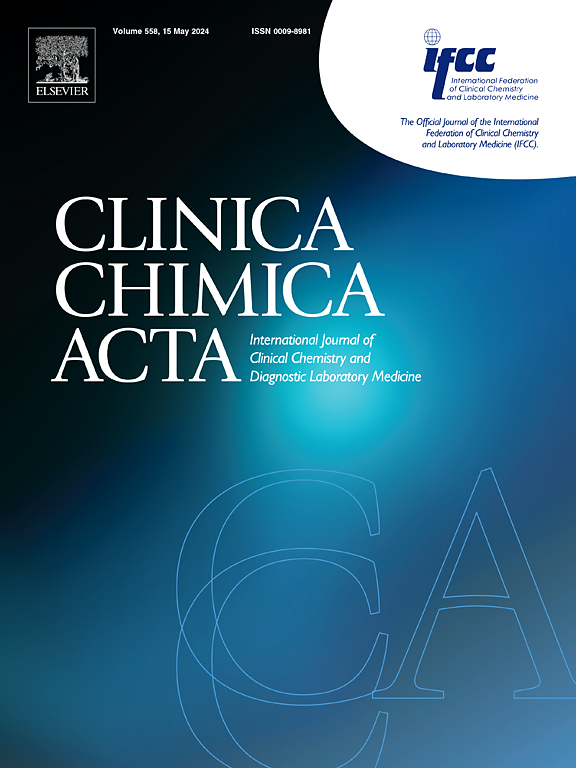基于生物信息学分析筛选强直性脊柱炎差异表达关键基因及其临床相关性研究
IF 2.9
3区 医学
Q2 MEDICAL LABORATORY TECHNOLOGY
引用次数: 0
摘要
目的通过综合生物信息学分析和病例对照验证,寻找强直性脊柱炎(AS)的潜在生物标志物,为了解AS的发病机制提供理论依据。方法首先进行综合生物信息学分析,结合文献综述,确定关键候选基因。在此之后,进行了一项病例对照验证研究,以验证这些基因的差异表达。结果初步筛选出61个差异表达基因(deg),综合分析并参考相关文献,筛选出ID2、PRF1、GZMB、S100A12 4个关键基因。qRT-PCR分析数据显示,AS患者中ID2、PRF1和GZMB的表达水平显著降低。ROC曲线下面积(AUC)显示,在单基因中,ID2的诊断效能最好,且4个关键基因的联合诊断效能优于单独使用ID2。ID2可能通过自然杀伤细胞和CD8细胞毒性T淋巴细胞调控下游PRF1和GZMB的凋亡过程,从而参与AS的发病机制。此外,本研究发现S100A12、PRF1和GZMB与多个反映炎症或疾病活动性水平的临床指标相关。结论我们通过生物信息学分析确定了4个关键的deg,并在病例对照研究中进一步验证了它们。结果表明,这些deg可能是诊断和治疗as的潜在分子靶点。本文章由计算机程序翻译,如有差异,请以英文原文为准。
Screening key genes differentially expressed in ankylosing spondylitis based on bioinformatics analysis and its clinical correlation study
Objective
This study aimed to identify potential biomarkers for Ankylosing Spondylitis (AS) through integrated bioinformatics analysis and case-control validation, thereby providing a theoretical basis for understanding the underlying pathogenesis of AS.
Methods
We first performed a comprehensive bioinformatics analysis integrated with a literature review to identify key candidate genes. Following this, a case-control validation study was carried out to verify the differential expression of these genes.
Results
Sixty-one differentially expressed genes (DEGs) were initially screened, and four key genes, ID2, PRF1, GZMB, and S100A12, were screened through comprehensive analysis and reference to relevant literature. Data from the qRT-PCR analysis indicated that the expression levels of ID2, PRF1, and GZMB were significantly reduced in patients with AS. The area under the ROC curve (AUC) indicated that among the single genes, ID2 had the best diagnostic performance, and the combined diagnostic performance of the four key genes was superior to that of ID2 alone. ID2 might regulate the apoptotic process of downstream PRF1 and GZMB through natural killer cells and CD8 cytotoxic T lymphocytes, thereby participating in the pathogenesis of AS. Furthermore, this study found that S100A12, PRF1 and GZMB were associated with multiple clinical indicators that reflected the level of inflammation or disease activity.
Conclusions
We identified four key DEGs via bioinformatics analysis and further validated them in case-control studies. The results indicated that these DEGs might serve as potential molecular targets for the diagnosis and treatment of AS.
求助全文
通过发布文献求助,成功后即可免费获取论文全文。
去求助
来源期刊

Clinica Chimica Acta
医学-医学实验技术
CiteScore
10.10
自引率
2.00%
发文量
1268
审稿时长
23 days
期刊介绍:
The Official Journal of the International Federation of Clinical Chemistry and Laboratory Medicine (IFCC)
Clinica Chimica Acta is a high-quality journal which publishes original Research Communications in the field of clinical chemistry and laboratory medicine, defined as the diagnostic application of chemistry, biochemistry, immunochemistry, biochemical aspects of hematology, toxicology, and molecular biology to the study of human disease in body fluids and cells.
The objective of the journal is to publish novel information leading to a better understanding of biological mechanisms of human diseases, their prevention, diagnosis, and patient management. Reports of an applied clinical character are also welcome. Papers concerned with normal metabolic processes or with constituents of normal cells or body fluids, such as reports of experimental or clinical studies in animals, are only considered when they are clearly and directly relevant to human disease. Evaluation of commercial products have a low priority for publication, unless they are novel or represent a technological breakthrough. Studies dealing with effects of drugs and natural products and studies dealing with the redox status in various diseases are not within the journal''s scope. Development and evaluation of novel analytical methodologies where applicable to diagnostic clinical chemistry and laboratory medicine, including point-of-care testing, and topics on laboratory management and informatics will also be considered. Studies focused on emerging diagnostic technologies and (big) data analysis procedures including digitalization, mobile Health, and artificial Intelligence applied to Laboratory Medicine are also of interest.
 求助内容:
求助内容: 应助结果提醒方式:
应助结果提醒方式:


